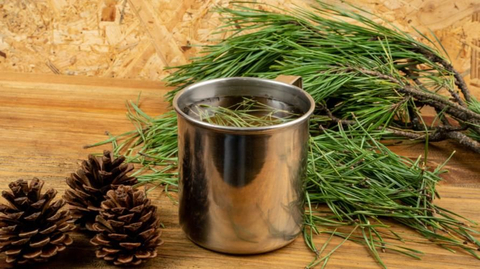Indonesia is a tropical region with abundant natural wealth, one of which is pine. The island of Java itself has pine forests of about 873,436.16 ha. However, the use of pine in Indonesia is still limited as soap, pulp, and paint. Developed countries such as Japan and Korea have utilized pine leaf extract in the fields of cosmetics, food, and medicine.
Green pine or Pinus merkusii is the only type of pine that grows in Indonesia and is spread in Aceh, Sumatra, and Java. For pine leaf production, Indonesia produces about 12.56-16.65 tons/hectare. However, pinus merkusii leaves have not been utilized to the maximum by the community because of the lack of knowledge about the potential of pine leaves. Pinus merkusii leaves essential oils contains Limonene, α-pinene, β-Caryophyllene, β-Ocimene, Germacrene-d, β-caryophyllene, caryophyllene oxide, α-humulene, flavonoids, tannins, and saponins.
The main components of pine in the form of α-pinene, β-pinene, and Limonene are active compounds of the terpenoid group. Terpenoids can cause bacterial membrane instability. Flavonoids mechanism performs as an antibacterial by forming complex compounds that are able to damage the cell membranes of bacteria. Cinnamic acid inhibits bacteria by inhibiting glucose enzymes so that bacteria lose ATP which causes bacterial growth to be inhibited and leads to bacterial death. Benzoic acid can reduce the intracellular pH of bacteria so that the process of bacterial glycolysis is inhibited. Tannins have a role in deactivating bacterial cell adhesion, inhibiting the enzyme reverse transcriptase and DNA topoisomerase, and reacting with cell wall polypeptides. Meanwhile, saponins as an antibacterial cause leakage of proteins and enzymes in cells.
Some herbal plants have been researched and utilized to control the growth of bacteria in the oral cavity to support improved dental health. But thus far there has been no research on the use of green pine leaves (Pinus merkusii) which is the only type of pine in Indonesia as an antibacterial oral cavity.
Basic Health Research data shows an increasing prevalence of dental and oral problems from 2007 and 2013, from 23.2% to 25.9% of caries cases (Riskesdas, 2013). Dental caries is an infectious disease that hits the hard tissues of the teeth. The process of damage to the hard tissues of the teeth through a chemical reaction by bacteria, starting with the process of damage to inorganic parts, then continuing in the organic part. Bacteria play an important role in the process of dental caries.
As a natural ingredient, the pine leaf extract is proven to contain active substances that can kill oral cavity bacteria. This opens opportunities for the utilization of pine leaf extract as a candidate for antibacterial agent ingredients.
Author: Dr. Dian Agustin Wahjuningrum, drg., SpKG(K) Detailed information from this research can be seen in our article at:
Microsoft Word – 18 D21_1472_Dian_Agustin_Wahjuningrum_Indonesia.doc (jidmr.com)
Dewa Made Wedagama, Dian Agustin Wahjuningrum, Ari Subiyanto, Fami Widya Pangestika, Kirana Guspiari, Setyabudi Goenharto, Velayutham Gopikrishna
Antibacterial Activity of Red Pine (Pinus densiflora) and Sumatran Pine (Pinus merkusii) Leaf Extracts against Oral Pathogens. Journal of International Dental and Medical Research. 2021:14(2) 559–562





